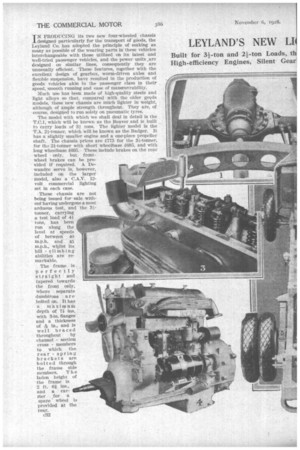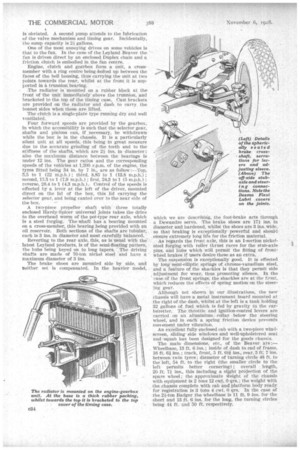LEYLAND'S NEW LI 'AST GOODS CHASSIS.
Page 16

Page 17

Page 18

If you've noticed an error in this article please click here to report it so we can fix it.
Built for 34-ton and 24-ton Loads, th, High-efficiency Engines, Silent Gear-,
Products from the Leylands Works have nIn Drive and Servo-operated Brakes.
IN PRODUCING its two new four-wheeled chassis designed particularly for the transport of goods, the Leyland Co. has adopted the principle of making as many as possible of the wearing parts in these vehicles Interchangeable with those utilized on its latest and well-tried passenger vehicles, and the power units ,are designed on similar lines, consequently they are unusually efficient. These features, together with the excellent design of gearbox, worm-driven axles and flexible suspension, have resulted in the production of goods vehicles akin to the passenger class in their speed, smooth running and ease of manceuvrability. Much use has been made of high-quality steels and light alloys so that, compared with the older gods models, these new chassis are much lighter in weight, although of ample strength throughout. They are, of course, designed to run solely on pneumatic tyres.
The model with which we shall deal in detail is the T.C.1; which will be known as the Beaver and is built to carry loads of 3 tons. The lighter model is the T.A. 21-tonner, which will be known as the Badger. It has a slightly smaller engine and a one-piece propeller shaft. The chassis prices are £775 for the 31-totirter, for the 24-tonner with short wheelbase £685, and with long wheelbase £695. These include brakes on the rear wheel only, but frontwheel brakes can be provided if required. A Dewandre servo is. however, included on the larger model, also a C.A.V. 12volt commercial lighting set in each case.
These chassis are not being issued for sale without having undergone a Most arduous test, and the 3itonner, carrying a test load of 41 tons, has been run along the level at speeds of between 40. m.p.h. and 45 m.p.h., whilst its hill climbing abilities are remarkable.
The frame is perfectly straight and tapered towards the front only, where separate dtunbirons a r e bolted on. It has a maximum depth of 71 ins. with 3-in, flanges and a thickness of -PG in., and is well braced throughout by channel section cross members to , which the rear spring brackets are bolted through the frame side members. T h e laden height of the frame is 2 ft. 61 his., and a carrier for a spare wheel is provided at the rear.
632 The company builds three -sizes of four-cylindered engine with overhead valves. Except for the number of cylinders, these engines are practically replicas of the power unit used in the Titan bus. The bore and stroke in the case of the engine in the 3/-tonner are 4/ ins. and 5/ ins, respectively, giving an R.A.C. rating of 28.9 h.p. and a h.h.p. of 43 at 1,000 r.p.m. This engine will give a smooth, even torque from 200 r.p.m. to 2,000 r.p.m. The cylinders are cast en bloc and the holding-down bolts pass right through to the five main bearings, which have a diameter of 24 ins. Nickel steel is utilized for the crankshaft, which is most carefully balanced.
All the engine auxiliaries are mounted at the near side, the magneto, which is driven through a Simms coupling, being situated above, and to the rear of, the line drive to the 4.13,nanto and water pump. A Duplex roller chain with a Coventry tensioner serves to drive the helical gears for the overhead camshaft, the helical pinion being split, and the parts held slightly apart by light springs, thus giving silence while running.
The camshaft runs in a bath of oil, and splashings of lubricant are directed into the camshaft bearings and on to the rockers by drip guides cast in one with the cover. A hot-spot is embodied between the inlet manifold and that for the exhaust.
The carburetter we saw on the model inspected was the latest M.O.-type vertical Solex which gives a remarkable snap opening from the slowest running speed ; it is equipped with an air cleaner.
It will be noted that the sparking plugs are arranged horizontally at the off side, which is otherwise perfectly. clear. An interesting
feature of the arrangement of these plugs is that,. Although positioned at the side, the points of flame propagation are practically in the centres of the cylinder heads, which is attained by providing small cored holes which communicate with the combustion chambers. "The bearings are particularly adequate, the total .projected area being 35.5 sq. ins.
The oiling system is closely akin to that used on the six-cylinderecl engines, with the exception that the large ; felt filter in the "former model, through which a certain
amount of the Is by-passed, is omitted, although adequate filtering is, of course, still ensured. A gear pump forces oil to all the main bearings and the bigends, and with the throttle fully open the pressure is kept at 80 lb. per sq. in., but a special oil-relief valve, which is CotiPled to the throttle, reduces this to 5 Ili. when the throttle is closed, thus over-oiling while idling is obviated. A second pump attends to the lubrication of the valve mechanism and timing gear. Incidentally, the sump capacity is 2A gallons.
One of the most annoying drives on some vehicles is that to the fan. In the case of the Leyland Beaver the fan is driven direct by an enclosed Duplex chain and a friction clutch is embodied in the fan centre.
Engine, clutch and gearbox form a unit, a cross member with a ring centre being bolted up between the faces of the bell housing, thus carrying the unit at two points towards the rear, whilst at the front it is supported in a trunnion. bearing.
The radiator is mounted on a rubber block at the front of the unit immediately, above the trunnion, and bracketed to the top of the timing caSe. Casthrackers are provided on the radiator and dash to carry the bonnet sides when these are lifted.
The clutch is a single-plate type running dry and well ventilated.
Four forward , speeds are provided by the gearbox, in which the accessibility is such that the selector gear, shafts and pinion's can, if _necessary, be withdrawn. while the box is in the chassis. It is a particularly silent unit at all speeds, •this being in great measure due to the accurate grinding of the teeth and to the stiffness of the shafts, which are 21 ins, in diameter ; also the maximum distance between the bearings is under 12 ins. The gear ratios and the corresponding speeds of the vehicles at 1,200 r.p.m. of the engine, the tyres fitted being 34 in. by 7 in., are as follow :---Top, 5.5 to 1 (22 m.p.h.) ; third, 8.85 to 1 (13.8 m.p.h.) ;
second, 113 to 1 -(7.9 ; first, 24.3 to 1. (5 ; reverse, 28.4 to 1 (4,3 rn.p.h.)., Control of the speeds is effected by a lever at -the left of the driver, mounted direct on the lid of the box, this lid carrying the selector gear, and being canted over to the near side of the box.
A two-piece propeller shaft with three totally enclosed Hardy-Spicer universal joints takes the drive to the overhead worm of the pot-type rear axle, which is a steel forging. The shaft has a hearing mounted on a cross-member, this bearing being provided with an oil reservoir. Both sections of the shafts are tubular, each is 3 ins, in diameter and most carefully balanced.
Reverting to the rear axle, this, as is usual with the. latest Leyland products, is of the semi-floating pattern, the hubs 'tieing keyed on to long tapers. The driving shafts are made of 70-ton nickel steel and have a maximum diameter of 3 ins.
The brake shoes are mounted side by. side, and neither set is compensated. In the heavier model,
which we are describing, the foot-brake acts through a Dewandre servo. The brake shoes are 17* ins. in diameter and hardened, whilst the shoes are 3 ins, wide, so that braking is exceptionally powerfnl and should ensure extremely long life for the friction material.
As regards the front axle, this is an 1-section nickelsteel forging with roller thrust races for the stub-axle pins, and hubs which will permit the fitting of front, wheel brakes if users desire these as an extra.
The suspension is exceptionally good. It is effected by long semi-elliptic springs of chrome-vanadium steel, and a feature of the shackles is that they permit side , adjustment for wear, thus promoting silence. In the ' ease of the front springs, the shackles are at the front, which reduces the effects of spring motion on the steering gear.
Although not shown in our illustrations, the new chassis will have a metal instrument board mounted at the right of the dash, whilst at the left is a tank holding 32 gallons of. fuel which is fed by gravity to the earluiretter. The throttle and ignition-control levers are carried on an aluminium collar below the steering wheel, and in each a spring 'friction device prevents movement under vibration.
An excellent fully enclosed cab with a two-piece windscreen, sliding side Windows and well-upholstered seat and 'squab has been designed for the goods chassis.
The main dimensions, etc,, of the Beaver are:— . Wheelbase, 13 ft. 6 ins. ; inside of dash to end of frame, 16 ft. 6-1 ins. ; track, front, 5 ft. 6-ti. ins., rear, 5 ft. 7 ins. between twin tyres; diameter of turning circle 48 ft. to the left, 54 ft. to the right (the smaller circle to the left permits better cornering) ; overall length, 20 ft; 7i ins., this including a slight projection of the spare wheel ; the approximate *eight of the chassis with equipment is 2 tons 12 cwt. 0 qrs.; the weight with the chassis complete with cab and platform body ready for registration is 3 tops 4 cwt. 0 qrs. In the ease of the 2i-ton Badger the wheelbase is 11 ft. 9 ins. for the short and 13 ft. 6 ins, for the long, the turning circles being 44 ft. and 50 ft. respectively.






























